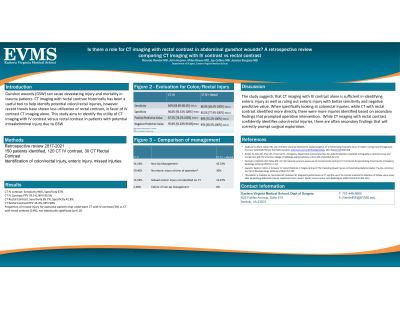Trauma
Category: Quickshot Oral Session 09
Quickshot Oral : Quickshot Oral Session 09
IS THERE A ROLE FOR CT IMAGING WITH RECTAL CONTRAST IN ABDOMINAL GUNSHOT WOUNDS? A RETROSPECTIVE REVIEW COMPARING CT IMAGING WITH IV CONTRAST VS RECTAL CONTRAST
Sunday, February 12, 2023
7:00am - 8:00am East Coast USA Time


Ricardo Rendel, MD
Resident
Eastern Virginia Medical School, United States
Ricardo Rendel, MD
Resident
Eastern Virginia Medical School, United States
Presenter(s)
Principal Contact(s)
Objectives: Compare effectiveness of identifying patients with colon/rectal injury on CT scans (IV vs IV and Rectal contrast) after sustaining an abdominal GSW
Is CT with IV contrast sufficient for surgical intervention due to secondary findings suggestive of injury making the use of rectal contrast unnecessary
Is there a role for CT with rectal contrast in penetrating gunshot wounds to the abdomen
Methods: A retrospective review was conducted of 915 patients admitted to a level 1 trauma hospital for gunshot wounds between 2017 and 2021. Patients were excluded if they were taken directly to the operating room without initial imaging or if the path of the GSW did not have potential to cause intraabdominal injury. There were 120 patients identified that underwent CT imaging with IV contrast. There were 30 patients that were identified that underwent CT imaging with rectal and IV contrast. Data included imaging identification of enteric injury, missed injury, non-operative management, surgical intervention and injuries identified intraoperatively.
Results: A total of 150 subjects were included, of these 120 had CT with IV contrast only, and 30 had CT with IV and rectal contrast. Among the subjects receiving IV contrast only, CT had a sensitivity of 96% and specificity of 67% (PPV 79.1%, NPV 93.5%) for identifying enteric injury. Among the subset receiving IV and rectal contrast, CT had a sensitivity of 85.7% and specificity of 42.8% (PPV 33.3%, NPV 90%). A subset analysis was done of patients with colorectal injuries. In the IV contrast group, there were 36 injuries with 23 specifically identified on CT. 12 patients went to the OR for other findings (pneumoperitoneum or other operative injury) and 1 injury was missed (3%). In the rectal contrast group, there were 7 injuries with the CT identifying 6 and 1 missed injury (14%). The proportion of missed injuries between the two was not statistically significant, p=.18.
Conclusion: The study suggests that CT imaging with IV contrast alone is sufficient in identifying enteric injury as well as ruling out enteric injury with better sensitivity and negative predictive value. When specifically looking at colorectal injuries, while CT with rectal contrast identified more directly, there were more injuries identified based on secondary findings that prompted operative intervention. While CT imaging with rectal contrast confidently identifies colon/rectal injuries, there are often secondary findings that will correctly prompt surgical exploration.
Is CT with IV contrast sufficient for surgical intervention due to secondary findings suggestive of injury making the use of rectal contrast unnecessary
Is there a role for CT with rectal contrast in penetrating gunshot wounds to the abdomen
Methods: A retrospective review was conducted of 915 patients admitted to a level 1 trauma hospital for gunshot wounds between 2017 and 2021. Patients were excluded if they were taken directly to the operating room without initial imaging or if the path of the GSW did not have potential to cause intraabdominal injury. There were 120 patients identified that underwent CT imaging with IV contrast. There were 30 patients that were identified that underwent CT imaging with rectal and IV contrast. Data included imaging identification of enteric injury, missed injury, non-operative management, surgical intervention and injuries identified intraoperatively.
Results: A total of 150 subjects were included, of these 120 had CT with IV contrast only, and 30 had CT with IV and rectal contrast. Among the subjects receiving IV contrast only, CT had a sensitivity of 96% and specificity of 67% (PPV 79.1%, NPV 93.5%) for identifying enteric injury. Among the subset receiving IV and rectal contrast, CT had a sensitivity of 85.7% and specificity of 42.8% (PPV 33.3%, NPV 90%). A subset analysis was done of patients with colorectal injuries. In the IV contrast group, there were 36 injuries with 23 specifically identified on CT. 12 patients went to the OR for other findings (pneumoperitoneum or other operative injury) and 1 injury was missed (3%). In the rectal contrast group, there were 7 injuries with the CT identifying 6 and 1 missed injury (14%). The proportion of missed injuries between the two was not statistically significant, p=.18.
Conclusion: The study suggests that CT imaging with IV contrast alone is sufficient in identifying enteric injury as well as ruling out enteric injury with better sensitivity and negative predictive value. When specifically looking at colorectal injuries, while CT with rectal contrast identified more directly, there were more injuries identified based on secondary findings that prompted operative intervention. While CT imaging with rectal contrast confidently identifies colon/rectal injuries, there are often secondary findings that will correctly prompt surgical exploration.

